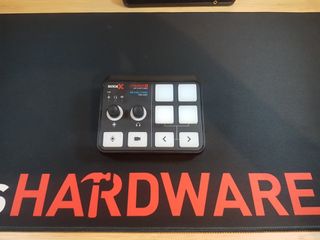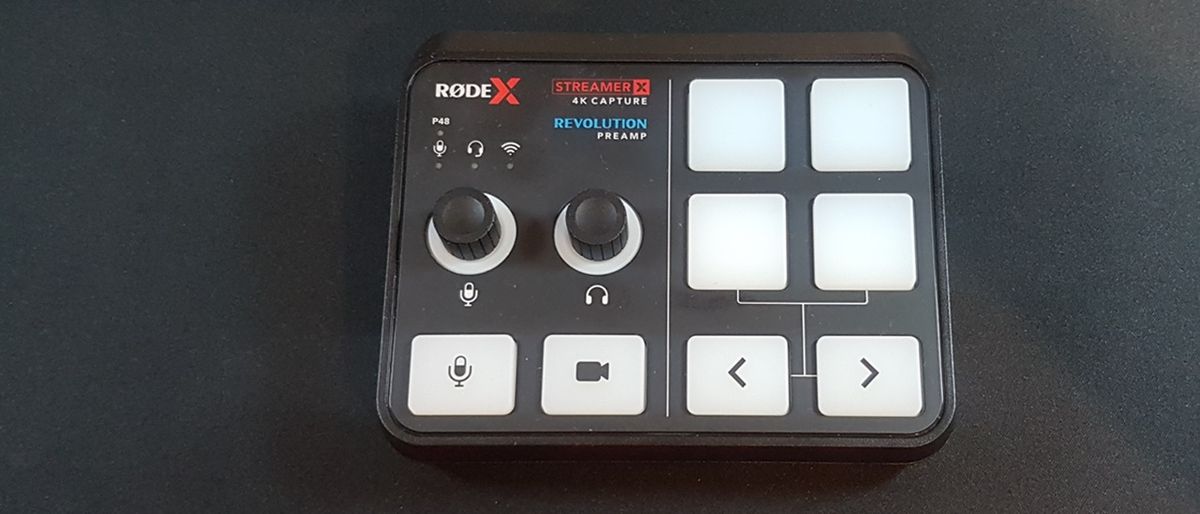Tom's Hardware Verdict
It's an interesting idea to combine a quality audio solution with a video capture card and also add the versatility of macro pads for the ultimate all-in-one device for streamers. But this slightly misses its mark, and although it means fewer devices and software, it doesn't decrease the fiddliness of operating your stream.
Pros
- +
Compact and portable peripheral for simple streaming setups
- +
Good amount of connectivity
- +
Colorful and functional Macro pad
Cons
- -
Expensive
- -
Only comes with one USB-C cable
- -
Relies heavily on software and a second screen
Why you can trust Tom's Hardware
Rode is no stranger to streaming and podcasting, with its high-quality microphones, mixers, and boom arms appearing in videos and VoDs all across the internet. But the Rode Streamer X is the first dedicated piece of equipment aimed at — and named for — the streaming market. The Streamer X combines Rode's audio mixing with a video capture card for the ultimate all-in-one streaming solution.
Design


The Streamer X's design is compact, cute, and rich with color when powered on. Shine-through rubberized buttons let programmable colors illuminate the Streamer X as well as indicate a range of functions. The chassis is constructed of a thick black plastic that feels very sturdy and reassuringly well put together with a surprisingly heavy (0.83 lbs/380 grams) weight for such a small object.
Measuring 122mm (4.8 inches) wide, 144 mm (5.6 inches) long, and 51mm (2 inches) tall, the Streamer X doesn’t take up much space on your desk and is easily transportable if you want to take this audio-video platform on the move. The Streamer X won’t slide about either because of having 4 grippy rubber feet, plus if you want to take the Streamer X off of your desk, you can, thanks to a mountable (¼” 20) screw on the underside of the Streamer X chassis that can conveniently connect to a monitor arm or mic stand.
The face and controls of the Streamer X consist of 2 control knobs and 8 large rubber buttons, with circular LED rings around the control knobs that indicate volume levels. There are also some tiny LED lights for indicating the connection of mic, headphone, wireless connection, and phantom power giving a surprising amount of information for having no display.
Specs
| Video Inputs | 1 x HDMI 2.0 input, 1 x HDMI 2.0 passthrough |
| Video Capture Resolutions | 4K/30, 1440p/60, 1080p/120, 1080p/60 HDR |
| Video Passthrough Resolutions | 4K/60 HDR, 1440p/144 HDR, 1080p/240 HDR |
| Frequency Range Mic Inputs | 20Hz - 20kHz |
| Frequency Range Monitor Outputs | 20Hz - 20kHz |
| Analogue Audio Inputs | 1 x XLR combo jack |
| Digital Audio Inputs | 2 x USB-C |
| Analogue Audio Outputs | 1 x 1/4-inch headphone outputs, 1 x 3.5 TRRS headset jack |
| Preamplifier Gain Range | 0 - 76dB |
| Phantom Power | 48 volt |
| Bit Depth | 24-bit |
| Sample Rate | 48kHz |
| Internal Storage | 2GB (SMART pads) |
| Weight | 13.28oz / 380g |
| Dimensions (H x W x L) | 5.6 x 4.8 x 2 inches / 144 x 122 x 51 mm |
| MSRP | $399 / £299 |
Features and Software


The primary purpose of the Streamer X is to combine a high-quality audio solution — with macro pad functionality — with an external video capture card. The Streamer X's video capture card can capture video at 4K/30fps, 1440p/60fps, 1080p/120fps, and 1080p/60fps with HDR enabled. It can also capture video at 4K/60fps, 1440p/144fps, 1080p/240fps with HDR passthrough. This is more than enough to connect the latest PCs, laptops, and gaming consoles, plus older retro consoles if you have a suitable adapter and converter.
A 4-button macro pad with multiple pages (2 pages as default) for adding sound/voice effects, or Midi functions adds to the Streamer X and lets you assign up to 64 different commands. To assign the commands to the smart pads you will need to use either Rodes Unify or Central software and a 3rd party Midi software to integrate the smart pads with a broadcasting application like OBS/Streamlabs or similar.
For the audio side of the Streamer X, you have plenty of connectivity with 1 x XLR combo jack, 1 x 1/4-inch headphone output, 1 x 3.5 TRRS headset jack, 2 x USB-C ports, 2 x HDMI 2.0 (Input & Passthrough)ports, and a 48 volt phantom power button for condenser mics. Inside the unit is Rode’s ultra-low-noise, high-gain Revolution Preamp tech, and their Aphex digital processing effects, the same tech used in the Rodecaster Pro 2 and Duo and other Rode products - so there’s no skimping on audio quality for this device.
With no screen, the Streamer X is predominantly controlled by the Rode Central and Rode Unify software on a PC or Mac. It’s beneficial to have a secondary monitor or more to get the most out of the Streamer X unless you want to do a lot of Alt-tabbing. I found this to be the biggest downside of the experience because if you’re using a passthrough screen to play the game live, you'll need (or, at least, want) another screen to check your streaming software/chat and sound level settings on the Rode software.
The Rode Central and Rode Unify software offer very similar user experiences and features, with Rode’s Unify software being encouraged as the software of choice for the Streamer X. You’re able to tweak the DSP audio, assign functions to the smart pads, control volumes, and route audio from the Streamer X itself, plus the USB-C connected device.
Bottom Line

At $399/£299 the Streamer X is a decent investment. But you're getting a premium audio experience and a highly portable external video capture card, plus a macro/smart pad for that money, and it's likely cheaper than buying all of those things separately. Also, having everything on one device is much more convenient for setup (and for saving desk space). For the best experience, I found it was nice to connect the second USB-C to the PC and set a separate audio channel for extra mixing — unfortunately, the Streamer X lacks a second USB-C cable in the box which is a little disappointing but not too difficult to remedy.
The Streamer X does what it sets out to do very well, and I can’t fault its performance while streaming console play and routing a separate microphone and Discord audio into a Twitch stream. I would have liked to see a small display that showed more information about the macro pad assignments, as you'll need to memorize the colors you've assigned to macro pad functions — and with 64 possible functions, that's just too much to commit to memory. A screen would also be helpful for audio mixing — right now you can only see the headphone and mic levels clearly, and any other audio sources are visible only via the Rode software.
While adding a screen would certainly change the price and scope of the Streamer X, bringing it closer to the level of the pricier Rodecaster Duo, perhaps there's room for a combination of the two. The Rodecaster Duo is for audio mixing and doesn't have a built-in video capture card, so it's not aimed at streamers the way the Streamer X is.

Stewart Bendle is a deals and coupon writer at Tom's Hardware. A firm believer in “Bang for the buck” Stewart likes to research the best prices and coupon codes for hardware and build PCs that have a great price for performance ratio.
